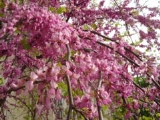
Cercis siliquastrum
Encyclopedia
Cercis siliquastrum, commonly known as Judas Tree, is a small deciduous
tree from Southern Europe
and Western Asia which is noted for its prolific display of deep-pink flowers in spring.
 This species forms a small tree up to 12 metres in height and 10 metres in width.
This species forms a small tree up to 12 metres in height and 10 metres in width.
The deep pink flowers are produced on year-old or older growth, including the trunk in late spring (cauliflory
). The leaves appear shortly after the first flowers emerge. These are heart-shaped with a blunt apex, which occasionally has a shallow notch at the tip. The tree produces long flat pods that hang vertically.
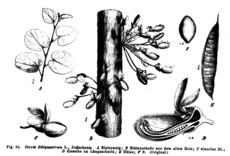 The species was first described by Linnaeus
The species was first described by Linnaeus
in 1753, who gave it the specific epithet of siliquastrum which is derived from the Latin
word siliqua, meaning "pod".
Varieties and subspecies include:
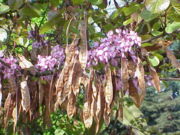
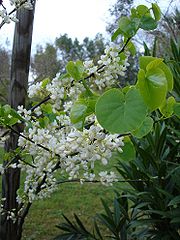
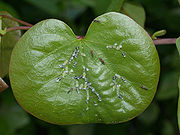 The species is native to Western Asia, including Iran
The species is native to Western Asia, including Iran
, Iraq
, Israel
, Jordan
, Lebanon
and Syria
and Southern Europe
including Albania
, Bulgaria
, France
, Greece
, Italy
, Turkey
and Former Yugoslavia
.
The flowers are pollinated by bees, attracted by nectar. Pollen from the protuding stamen
s is deposited on the bee's body and carried to another flower's stigma
.
Cultivars include:
The tree is susceptible to leafhoppers, scale insects and psyllids (specifically Cacopsylla pulchella) as well as diseases including canker
, coral spot and verticillium wilt
.
Propagation is by seed, cuttings or budding.
The species produces hard wood with an attractive grain. It is used in veneers and polishes well.
hanged himself from a tree of this species. This belief is related to the common name "Judas Tree" which is possibly a corrupted derivation from the French common name, Arbre de Judée meaning tree of Judea
, referring to a region where the tree occurs.
Deciduous
Deciduous means "falling off at maturity" or "tending to fall off", and is typically used in reference to trees or shrubs that lose their leaves seasonally, and to the shedding of other plant structures such as petals after flowering or fruit when ripe...
tree from Southern Europe
Southern Europe
The term Southern Europe, at its most general definition, is used to mean "all countries in the south of Europe". However, the concept, at different times, has had different meanings, providing additional political, linguistic and cultural context to the definition in addition to the typical...
and Western Asia which is noted for its prolific display of deep-pink flowers in spring.
Description

The deep pink flowers are produced on year-old or older growth, including the trunk in late spring (cauliflory
Cauliflory
Cauliflory is a botanical term referring to plants which flower and fruit from their main stems or woody trunks rather than from new growth and shoots. This can allow trees to be pollinated or have their seeds dispersed by animals which cannot climb or fly...
). The leaves appear shortly after the first flowers emerge. These are heart-shaped with a blunt apex, which occasionally has a shallow notch at the tip. The tree produces long flat pods that hang vertically.
Taxonomy

Carolus Linnaeus
Carl Linnaeus , also known after his ennoblement as , was a Swedish botanist, physician, and zoologist, who laid the foundations for the modern scheme of binomial nomenclature. He is known as the father of modern taxonomy, and is also considered one of the fathers of modern ecology...
in 1753, who gave it the specific epithet of siliquastrum which is derived from the Latin
Latin
Latin is an Italic language originally spoken in Latium and Ancient Rome. It, along with most European languages, is a descendant of the ancient Proto-Indo-European language. Although it is considered a dead language, a number of scholars and members of the Christian clergy speak it fluently, and...
word siliqua, meaning "pod".
Varieties and subspecies include:
- var. hebecarpa Bornm.
- nothosubsp. yaltikirii (Ponert) Govaerts
- var. siliquastrum
- var. alba Weston
Distribution and ecological aspects



Iran
Iran , officially the Islamic Republic of Iran , is a country in Southern and Western Asia. The name "Iran" has been in use natively since the Sassanian era and came into use internationally in 1935, before which the country was known to the Western world as Persia...
, Iraq
Iraq
Iraq ; officially the Republic of Iraq is a country in Western Asia spanning most of the northwestern end of the Zagros mountain range, the eastern part of the Syrian Desert and the northern part of the Arabian Desert....
, Israel
Israel
The State of Israel is a parliamentary republic located in the Middle East, along the eastern shore of the Mediterranean Sea...
, Jordan
Jordan
Jordan , officially the Hashemite Kingdom of Jordan , Al-Mamlaka al-Urduniyya al-Hashemiyya) is a kingdom on the East Bank of the River Jordan. The country borders Saudi Arabia to the east and south-east, Iraq to the north-east, Syria to the north and the West Bank and Israel to the west, sharing...
, Lebanon
Lebanon
Lebanon , officially the Republic of LebanonRepublic of Lebanon is the most common term used by Lebanese government agencies. The term Lebanese Republic, a literal translation of the official Arabic and French names that is not used in today's world. Arabic is the most common language spoken among...
and Syria
Syria
Syria , officially the Syrian Arab Republic , is a country in Western Asia, bordering Lebanon and the Mediterranean Sea to the West, Turkey to the north, Iraq to the east, Jordan to the south, and Israel to the southwest....
and Southern Europe
Southern Europe
The term Southern Europe, at its most general definition, is used to mean "all countries in the south of Europe". However, the concept, at different times, has had different meanings, providing additional political, linguistic and cultural context to the definition in addition to the typical...
including Albania
Albania
Albania , officially known as the Republic of Albania , is a country in Southeastern Europe, in the Balkans region. It is bordered by Montenegro to the northwest, Kosovo to the northeast, the Republic of Macedonia to the east and Greece to the south and southeast. It has a coast on the Adriatic Sea...
, Bulgaria
Bulgaria
Bulgaria , officially the Republic of Bulgaria , is a parliamentary democracy within a unitary constitutional republic in Southeast Europe. The country borders Romania to the north, Serbia and Macedonia to the west, Greece and Turkey to the south, as well as the Black Sea to the east...
, France
France
The French Republic , The French Republic , The French Republic , (commonly known as France , is a unitary semi-presidential republic in Western Europe with several overseas territories and islands located on other continents and in the Indian, Pacific, and Atlantic oceans. Metropolitan France...
, Greece
Greece
Greece , officially the Hellenic Republic , and historically Hellas or the Republic of Greece in English, is a country in southeastern Europe....
, Italy
Italy
Italy , officially the Italian Republic languages]] under the European Charter for Regional or Minority Languages. In each of these, Italy's official name is as follows:;;;;;;;;), is a unitary parliamentary republic in South-Central Europe. To the north it borders France, Switzerland, Austria and...
, Turkey
Turkey
Turkey , known officially as the Republic of Turkey , is a Eurasian country located in Western Asia and in East Thrace in Southeastern Europe...
and Former Yugoslavia
Former Yugoslavia
The former Yugoslavia is a term used to describe the present day states which succeeded the collapse of the Socialist Federal Republic of Yugoslavia....
.
The flowers are pollinated by bees, attracted by nectar. Pollen from the protuding stamen
Stamen
The stamen is the pollen producing reproductive organ of a flower...
s is deposited on the bee's body and carried to another flower's stigma
Stigma
Stigma is a word that originally means a "sign", "point", or "branding mark". It may refer to:-As a symbolic mark:* The Mark of Cain* Stigmata, bodily marks or wounds resembling the crucifixion wounds of Jesus...
.
Cultivation
The species prefers deep, well-drained soils and a position in full sun or partial shade.Cultivars include:
- 'Afghan Deep Purple'
- 'Alba' - white flowers
- 'Bodnant'
- 'Carnea'
- 'Fructa Rubra'
- 'Penduliflora'
- 'Rubra' - dark pink-purple flowers
- 'Sterilis'
- 'Variegata'
- 'White Swan'
The tree is susceptible to leafhoppers, scale insects and psyllids (specifically Cacopsylla pulchella) as well as diseases including canker
Canker
Canker and anthracnose are general terms for a large number of different plant diseases, characterised by broadly similar symptoms including the appearance of small areas of dead tissue, which grow slowly, often over a period of years. Some are of only minor consequence, but others are ultimately...
, coral spot and verticillium wilt
Verticillium wilt
Verticillium Wilt is a wilt disease of over 300 species of eudicot plants caused by one of two species of Verticillium fungus, V. dahliae and V. albo-atrum. Many economically important plants are susceptible including cotton, tomatoes, potatoes, eggplants, peppers and ornamentals, as well as others...
.
Propagation is by seed, cuttings or budding.
The species produces hard wood with an attractive grain. It is used in veneers and polishes well.
History
There is a longstanding myth that Judas IscariotJudas Iscariot
Judas Iscariot was, according to the New Testament, one of the twelve disciples of Jesus. He is best known for his betrayal of Jesus to the hands of the chief priests for 30 pieces of silver.-Etymology:...
hanged himself from a tree of this species. This belief is related to the common name "Judas Tree" which is possibly a corrupted derivation from the French common name, Arbre de Judée meaning tree of Judea
Judea
Judea or Judæa was the name of the mountainous southern part of the historic Land of Israel from the 8th century BCE to the 2nd century CE, when Roman Judea was renamed Syria Palaestina following the Jewish Bar Kokhba revolt.-Etymology:The...
, referring to a region where the tree occurs.
Cultural references
- The Judas Tree (Jonathan Creek)The Judas Tree (Jonathan Creek)"The Judas Tree" is the twenty-seventh episode of the British crime drama series Jonathan Creek. The feature-length episode was written and directed by series creator David Renwick, and premiered on BBC One on 4 April 2010...
- Flowering Judas by Katherine Anne PorterKatherine Anne PorterKatherine Anne Porter was a Pulitzer Prize-winning American journalist, essayist, short story writer, novelist, and political activist. Her 1962 novel Ship of Fools was the best-selling novel in America that year, but her short stories received much more critical acclaim...
- Fictionally used to poison The DoctorDoctor (Doctor Who)The Doctor is the central character in the long-running BBC television science-fiction series Doctor Who, and has also featured in two cinema feature films, a vast range of spin-off novels, audio dramas and comic strips connected to the series....
in the 2011 episode of Doctor Who, "Let's Kill HitlerLet's Kill Hitler"Let's Kill Hitler" is the eighth episode of the sixth series of the British science fiction television series Doctor Who, and was first broadcast on BBC One, Space and BBC America on 27 August 2011. It is the second episode of a two-part story, continuing stories from "A Good Man Goes to War"...
"

